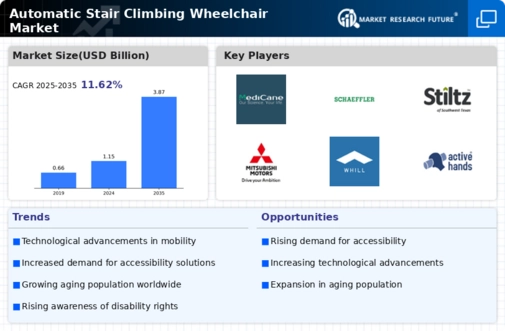Government Initiatives and Funding
The Automatic Stair Climbing Wheelchair Market is positively impacted by various government initiatives aimed at improving accessibility for individuals with disabilities. Many governments are implementing policies that provide funding and support for the development and distribution of mobility aids, including automatic stair climbing wheelchairs. These initiatives often include grants, tax incentives, and subsidies that encourage innovation and make these devices more affordable for consumers. Recent reports indicate that government spending on disability-related services is expected to increase, further stimulating the market. As these policies take effect, the Automatic Stair Climbing Wheelchair Market is likely to benefit from enhanced investment and a broader consumer base, ultimately leading to increased sales and market penetration.
Growing Focus on Health and Wellness
The Automatic Stair Climbing Wheelchair Market is also influenced by the growing focus on health and wellness among consumers. As awareness of the importance of physical activity and mobility increases, there is a corresponding demand for products that facilitate movement and independence. Automatic stair climbing wheelchairs are seen as essential tools that not only enhance mobility but also promote an active lifestyle for individuals with disabilities. Market Research Future indicates that consumers are increasingly prioritizing products that support their health and well-being, leading to a rise in demand for innovative mobility solutions. This trend suggests that the Automatic Stair Climbing Wheelchair Market will continue to evolve, with manufacturers focusing on creating products that align with the health-conscious mindset of today's consumers.
Rising Awareness of Disability Rights
The Automatic Stair Climbing Wheelchair Market is significantly influenced by the increasing awareness of disability rights and the importance of accessibility. Advocacy groups and governmental bodies are actively promoting initiatives that ensure individuals with disabilities have equal access to public spaces. This heightened awareness has led to a growing demand for innovative mobility solutions, including automatic stair climbing wheelchairs. As more public buildings and transportation systems adopt accessibility standards, the market is expected to expand. Recent statistics indicate that approximately 15% of the population lives with some form of disability, underscoring the necessity for effective mobility solutions. Consequently, the Automatic Stair Climbing Wheelchair Market is poised for growth as it aligns with these societal shifts towards inclusivity.
Aging Population and Increased Mobility Needs
The Automatic Stair Climbing Wheelchair Market is witnessing growth driven by the aging population, which is increasingly seeking mobility solutions that cater to their specific needs. As individuals age, they often face mobility challenges that can hinder their independence. The demand for automatic stair climbing wheelchairs is rising as these devices provide a practical solution for navigating stairs and other obstacles. Data suggests that by 2030, the number of individuals aged 65 and older will reach approximately 1.5 billion, creating a substantial market for mobility aids. This demographic shift indicates a pressing need for innovative solutions within the Automatic Stair Climbing Wheelchair Market, as manufacturers strive to develop products that enhance the quality of life for older adults.
Technological Innovations in Mobility Devices
The Automatic Stair Climbing Wheelchair Market is experiencing a surge in technological innovations that enhance the functionality and usability of mobility devices. Advanced robotics and artificial intelligence are being integrated into these wheelchairs, allowing for smoother navigation of stairs and uneven surfaces. This technological evolution not only improves user experience but also increases safety, as modern designs often include features such as automatic braking and obstacle detection. According to recent data, the market for mobility devices is projected to grow at a compound annual growth rate of approximately 8% over the next five years, driven by these advancements. As manufacturers continue to invest in research and development, the Automatic Stair Climbing Wheelchair Market is likely to see a proliferation of new models that cater to diverse user needs.


















Leave a Comment